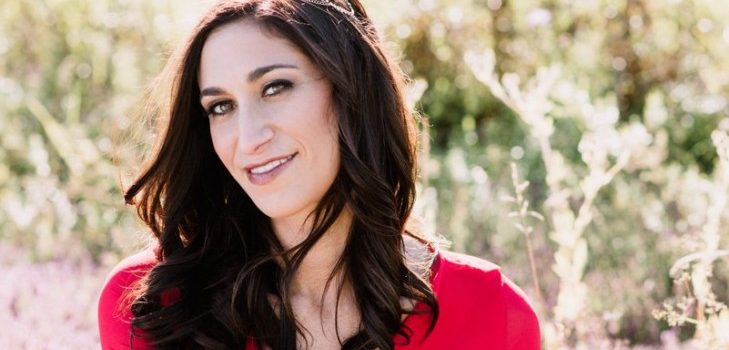The Sound of Sephardic Music
Singer/songwriter Sarah Aroeste made it her life’s work to revive Sephardic culture and teach Ladino to a new generation of Jews through her music.
In an essay that singer/songwriter Sarah Aroeste published in Tablet Magazine last year, she wrote: “I was confused by the fact that my grandfather referred to his homeland as Greece, called himself a Turk, and said he spoke Spanish. What was this mishmash?” Her grandfather was a Sephardic Jew whose family traced its roots to 14th-century Spain and fled during the Inquisition to what is now Macedonia.
That “mishmash” of her family’s cultures and languages intrigued Aroeste, and she explored her Sephardic roots through music. A trained opera singer, Aroeste gravitated toward Ladino music in college after she spent a summer studying opera in Tel Aviv. After she returned to America, Aroeste performed in a series of recitals, in which she included Ladino music in her performances. Audience members told her the Ladino portion of her program was their favorite. That’s when Aroeste understood that singing in Ladino was her newfound passion and preserving the language would be her life’s work.
Aroeste recently talked to JewishBoston about her new album, “Together/Endjunto,” and her dedication to Sephardic culture. Aroeste reads and writes Ladino, but is a hesitant speaker. She likes to say, however, that she sings in Ladino fluently, and notes that she is reviving the language one song at a time.
Did you learn Ladino and about Sephardic culture from your family?
My family came to America in 1912 from what is now Macedonia. They were fleeing from the Balkan War. There was an interweaving of cultures in my family, and as a child, I didn’t know what it all meant. I was so curious to know more. But my family wanted to leave the old country behind and assimilate quickly. They didn’t pass on many traditions, such as Ladino. But they were clearly proud of their heritage and preserved it through stories, food and songs. But I always felt there was a gap, and I decided to search for the answers. The medium in which I felt most comfortable exploring my Sephardic heritage was music. I write my music in Ladino.
Do you think Ladino is headed for a revival?
There is a slow and steady revival of the Ladino language. But we’re at a disadvantage in that we [Sephardim] don’t have the same number of speakers, musicians and overall enthusiasts that there are in the Yiddish world. The breadth of Jewish musical creativity that was happening in the early aughts was astonishing. Klezmer music was just peaking, and while that was very inspiring, I was sad that there was no real Sephardic counterpart. That prompted me to start my own work in Ladino music. Jewish music is in such a great place, but we need more people willing to take bigger risks with Sephardic music. It’s a tricky line to walk, in that we want to preserve our culture, but we have to be careful how we put forth that culture. To keep the culture alive and breathing, we need to show new generations that this is not just for our grandparents. We need to write new music.
You also have an original album for children. Tell us about that.
The album is called “Ora de Despertar” (“Time to Wake Up”). The title is addressed to both children and adults. It’s time to wake up this tradition for children. For adults, it’s time to wake up and teach our children this culture. If we don’t do it, it will fade away. The album comes with an extensive educational packet to engage families in Sephardic music and culture. We also need to show that Sephardic culture is an essential part of Jewish culture. You just can’t separate it out; it’s part of the larger Jewish story.
What does the album’s title, “Together/Endjuntos,” signify?
First, it’s a holiday album, and holidays are meant to be spent together. This is an album to be experienced as a family; all ages can enjoy it together. The second meaning is more literal, in that it shows how English and Ladino are intertwined throughout the album. It’s the first bilingual album I’ve recorded. I purposely did that so more people would be exposed to Ladino; including English makes it easier to do that. I’m not diluting Ladino—I’m giving more people access to Ladino through English. So many Jewish musicians of all stripes bring music into the mainstream. I don’t want Ladino music to be a separate entity. I want Ladino to be endjunto—together with other Jewish music. There is no reason to separate it from Jewish music in general.
What does the Jewish-Latino connection mean to you and your music?
I’m filming a documentary on Sept. 23 based on my song “Buen Shabat,” which is the most Latino piece on the album. It’s a merengue. I’m working with a salsa group to make it a full Latino-Jewish Shabbat experience. We’re planning on also doing a music video that day.
Like so many cultures in this globalized world, Sephardim are all over the world. We’re all over Latin America. So many people are unaware of Latino Jews. Or it works the other way—people assume that all Latino Jews are Sephardic. There is so much misperception of Latino Jews’ intersectionality—you can speak Spanish and be Jewish at the same time. I wanted to celebrate the universalism of all these cultures. For example, in the song “Baylamos” (“Let’s Dance”), I wanted to highlight a Bhangra Indian beat, and I worked with a community in Mumbai. Jews are universal, and I want to celebrate the togetherness of our various cultures.

